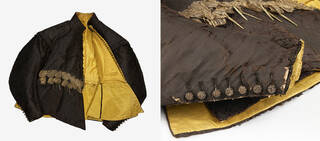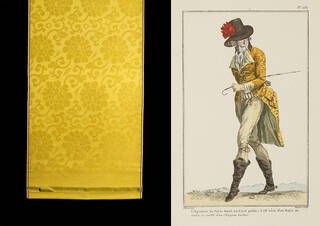For centuries, colour in men's clothing has been a means for both imposing conformity, or expressing individuality. The associations of colour have changed over time – In the 1700s European men wore pink, for example, as a sign of wealth and power, rather than gender. Today the spectrum of colours has become symbolic of both liberation and visibility in menswear.
Before synthetic dyes were developed in the 1850s, colourful clothing was the preserve of the powerful, as dyes were expensive to create. In the mid-19th century, a variety of brilliant hues started to become more widely available, and yet menswear became relatively restrained in this period. By the 1960s and '70s however, colour had made a comeback. At the time when the Rainbow Flag was created as a symbol of gay pride, from New York's Greenwich Village to London's Soho, male peacocks relished the expressive possibilities of colour.
Red
Red is an enduring symbol of power. Its associations with bravery and robustness flourished in the 16th century, when cochineal – a vivid and intense dye – was introduced to Europe from Mexico. Cochineal became a highly valuable commodity, capable of creating deep shades of crimson, like the colour of this 17th-century silk doublet.
Pink
As a shade of red, pink shared its connotations of vigour and was worn freely by fashionable men – it was only in the first half of the 20th century that pink became associated with femininity. Those who could afford the expensive dyes imported from South Asia and South America dressed in shades of pink ranging from salmon to raspberry and magenta. Vibrant suits were paired with glinting metallic accessories, from shining buttons to embellished snuffboxes.

India is famous for an unparalleled range of red and pink dyes. A vibrant raspberry silk is the basis for this richly decorated courtly angarkha (robe), which would have been worn by a young man. In South Asia, pink has remained a unisex colour.
Today, designers like Harris Reed are embracing all shades of pink, subverting 20th-century gender norms and connecting with the flamboyance and freedom of historical fashions. Pastels can be especially powerful. Designers internationally have embraced and experimented with pale pink to disrupt expectations. PRONOUNCE's Zhongshan or 'Mao' suit, for example, features crisp, functional tailoring, though its political associations are subverted by its colour.

Black
"Black is more pleasing in clothing than any other colour."
The fashion for black began at the Spanish court. During the 16th and 17th centuries, the colour black was associated with dignity and was worn by wealthy, educated and powerful men. This doublet is a rare survival, as the iron compounds used to create black have weakened the fabric. It was an expensive garment: the silk is shot through with silver and the gauze ribbon bows are tipped with silver points. Its dark sheen contrasts with the equally costly needle lace collar, while the yellow silk lining suggests a wearer with a fine sense of drama.

Industrial milling and mass-production from the 19th century onwards made the black suit a uniform of modernity accessible to all. Fine woollen cloth in a dark, sombre palette, became the new status symbol. By the mid-19th century, every fashionable European gentleman owned at least one frock coat. The boulevards and arcades of expanding industrialised cities like London and Paris were populated by soberly and uniformly dressed men.

Orange
Orange was fashionable among European men from about 1740, when new recipes mixed red and yellow dyes to create the colour. This vibrant silk coat, only half of which survives, would have been a significant purchase for its original owner. Two centuries later, in the 1960s, psychedelia exploited the jollity of orange in unexpected textiles. Flamboyant London designer Mr Fish transformed striped orange furnishing fabric, bought in the USA, into an optically dazzling, attention grabbing suit, for interior designer David Mlinaric.
Yellow
In China, bright yellow was an exclusive, imperial colour, reserved for the emperor, empress and dowager empress from the 1630s. The colour became fashionable in 18th-century Europe as part of the wider taste for Chinese products and designs. This length of Chinese yellow silk damask, patterned with scrolling peonies and rhinoceros horn motifs, would have been made for the export market.

In 1960s London, Carnaby Street fashionistas appropriated Indian designs, like the shape of this coat, a 'Nehru jacket', named after those worn by Indian Prime Minister Jawaharlal Nehru (1889 – 1964). The style was popular during the Swinging Sixties 'peacock revolution', a bold approach to dress aimed at breaking away with social and sartorial traditions.
Green
Although green evokes nature in clothing, few plants yield a green dye, which was achieved instead by mixing blue and yellow. The woven green stripes against the plain blue silk of this 18th-century frock coat enhance its verdant tones, making the colour even more vibrant and shiny.
A similar effect is created in this ensemble by Italian-Haitian designer Stella Jean, who plays with the different geometrical patterns of textiles sourced from Burkina Faso in West Africa. Jean sees fashion's potential as 'a cultural translator and a tool against colonisation; it re-establishes the balance between symbols, stories and different worlds through style'.
Indigo
Historically, blue and purple were regal colours. Indigo dye was an expensive commodity which created frenzied global trade. Purple's imperial connection dates from Ancient Rome, when only emperors could afford 'Tyrian' dye, worth its weight in gold. Contemporary Savile Row designer Ozwald Boateng has reappropriated peacock-brights for newly powerful formal wear. Boateng's commitment to his signature purple is partially inspired by his Ghanaian heritage.
Roselle hibiscus, native to West Africa, and its vivid hues are usually associated with feminine Nigerian attire. The brand Orange Culture, founded by Adebajo Oke-Lawal, reclaims bright colours and floral motifs, celebrating 'softer' masculine identities and utilising sheer materials which speak of Oke-Lawal's fluid approach: "We can be emotional, vulnerable and express ourselves however we want to, without being seen as anything less than African".













